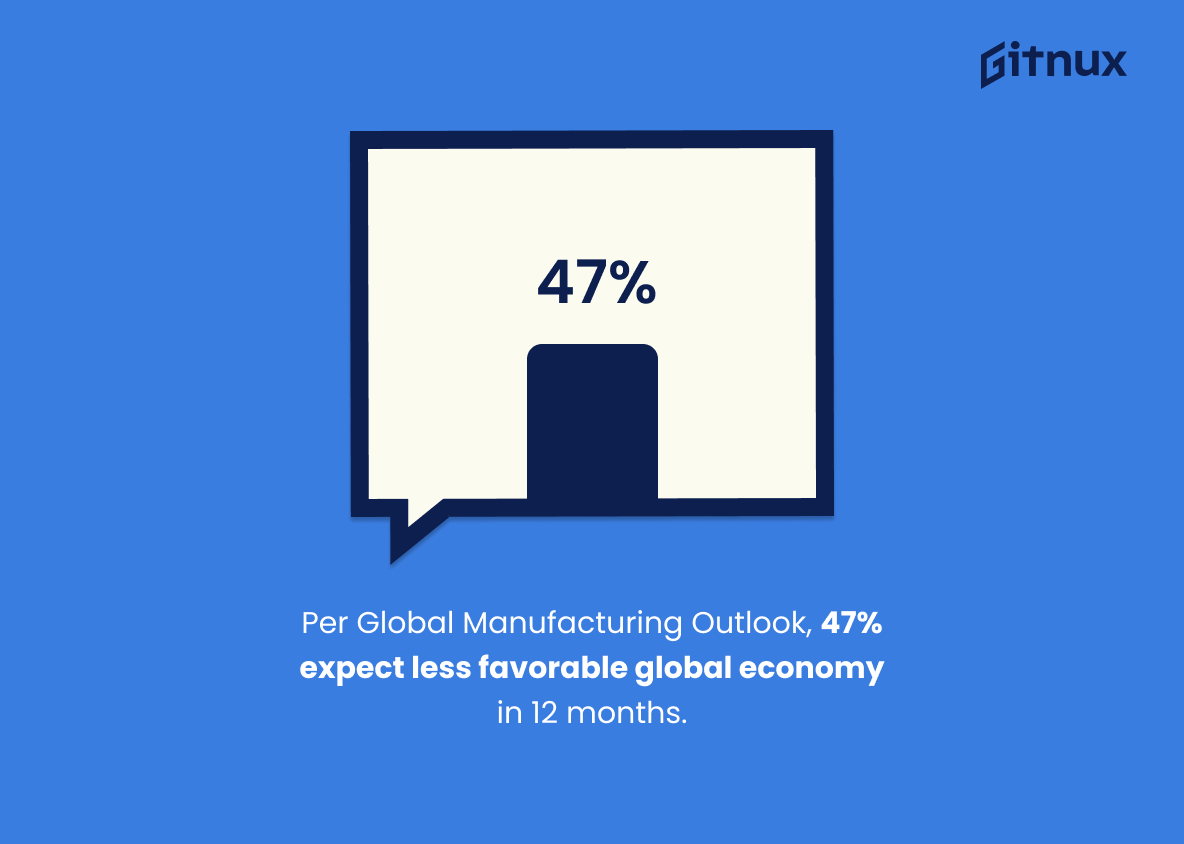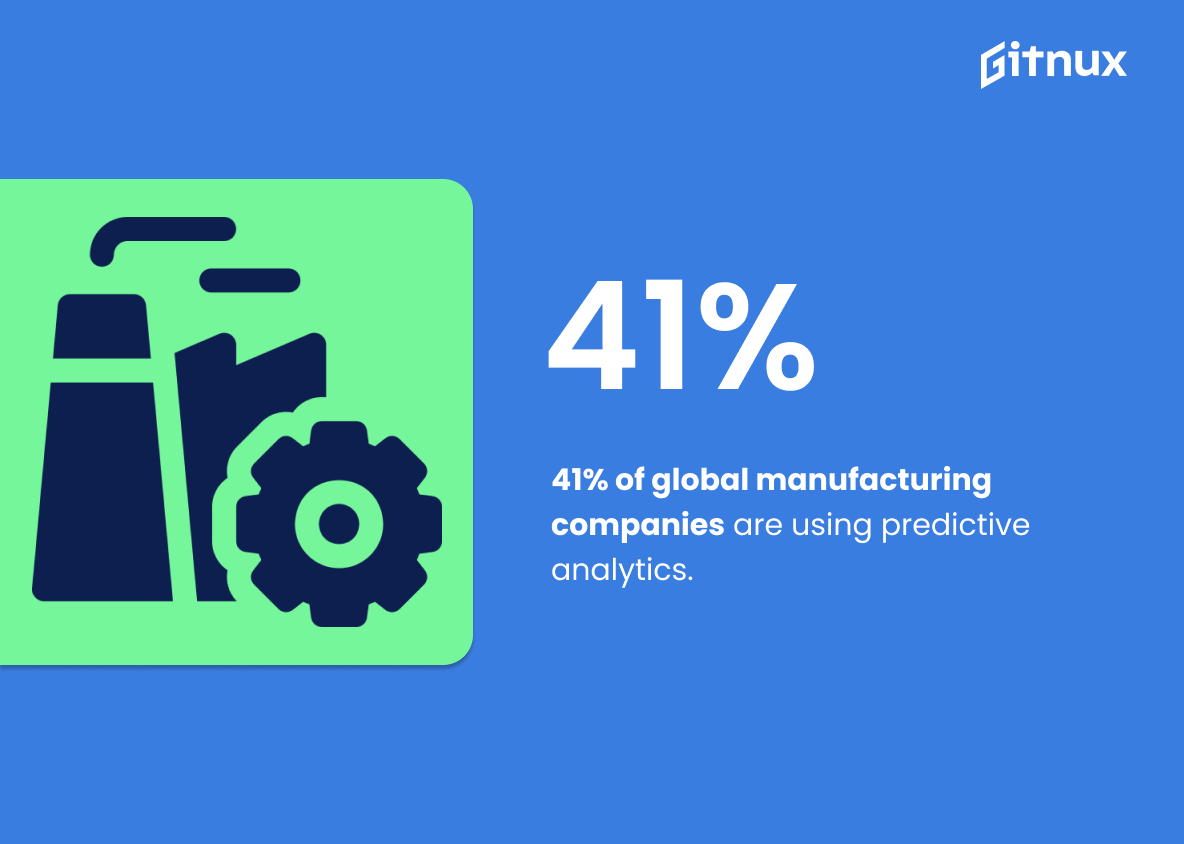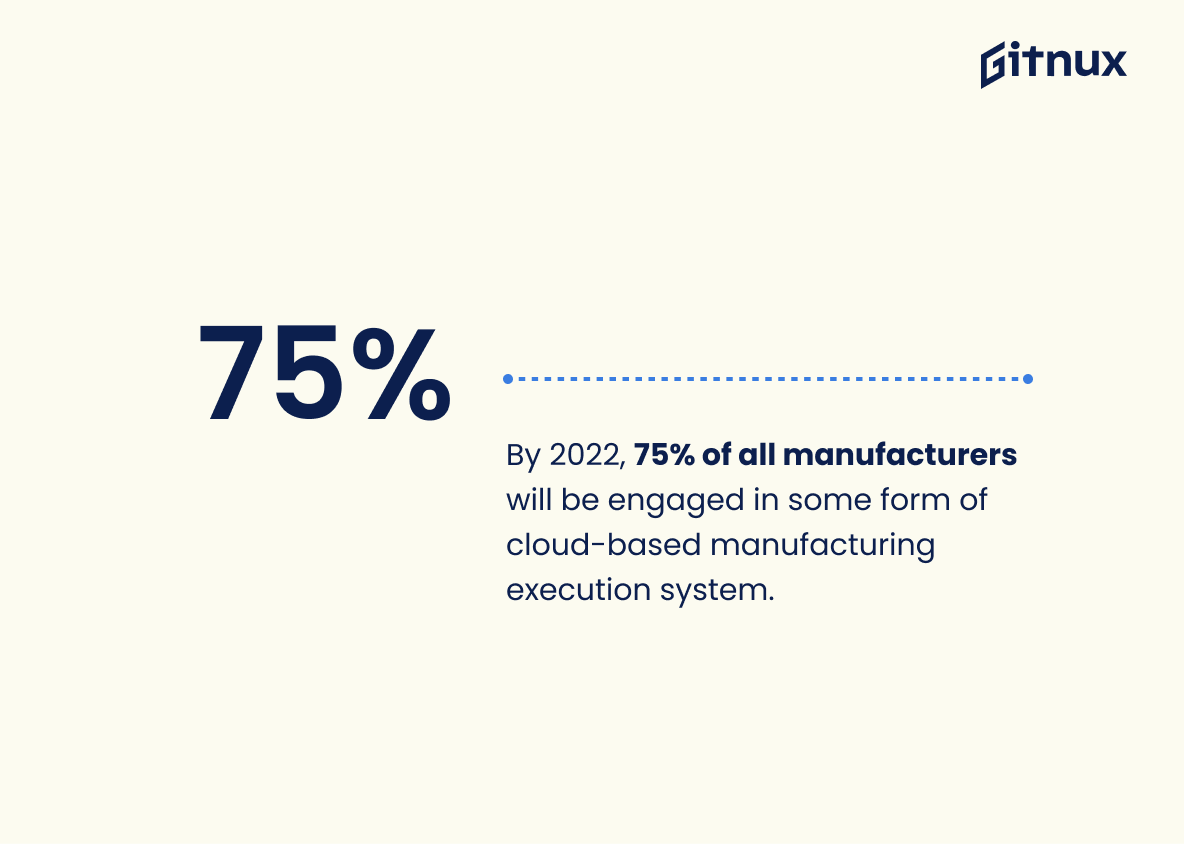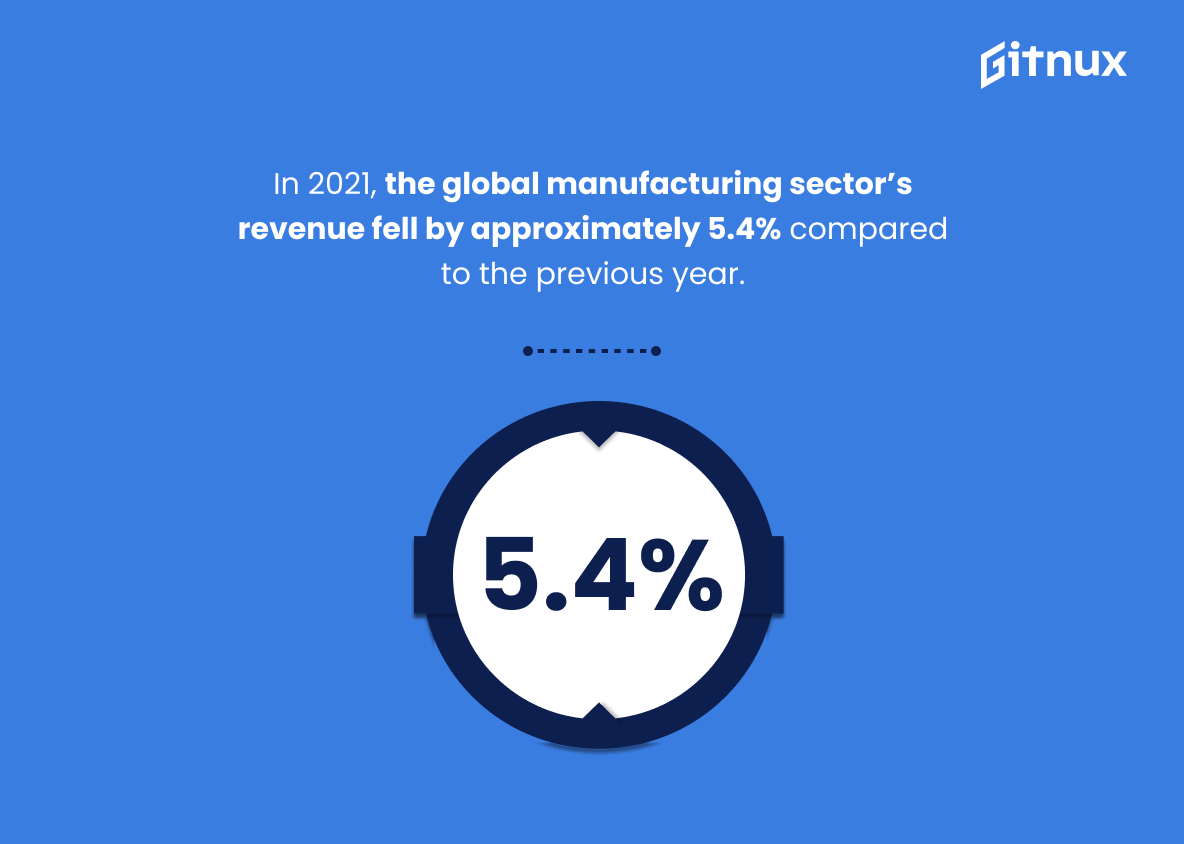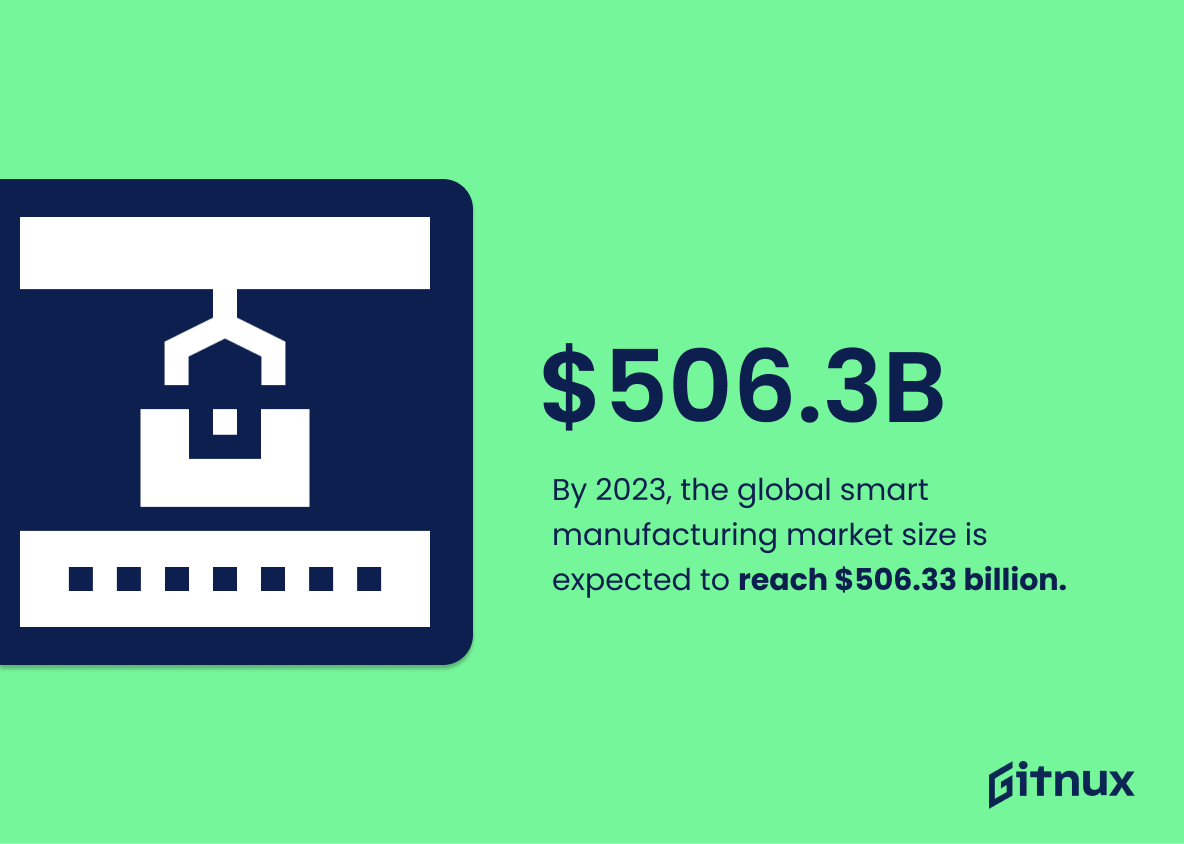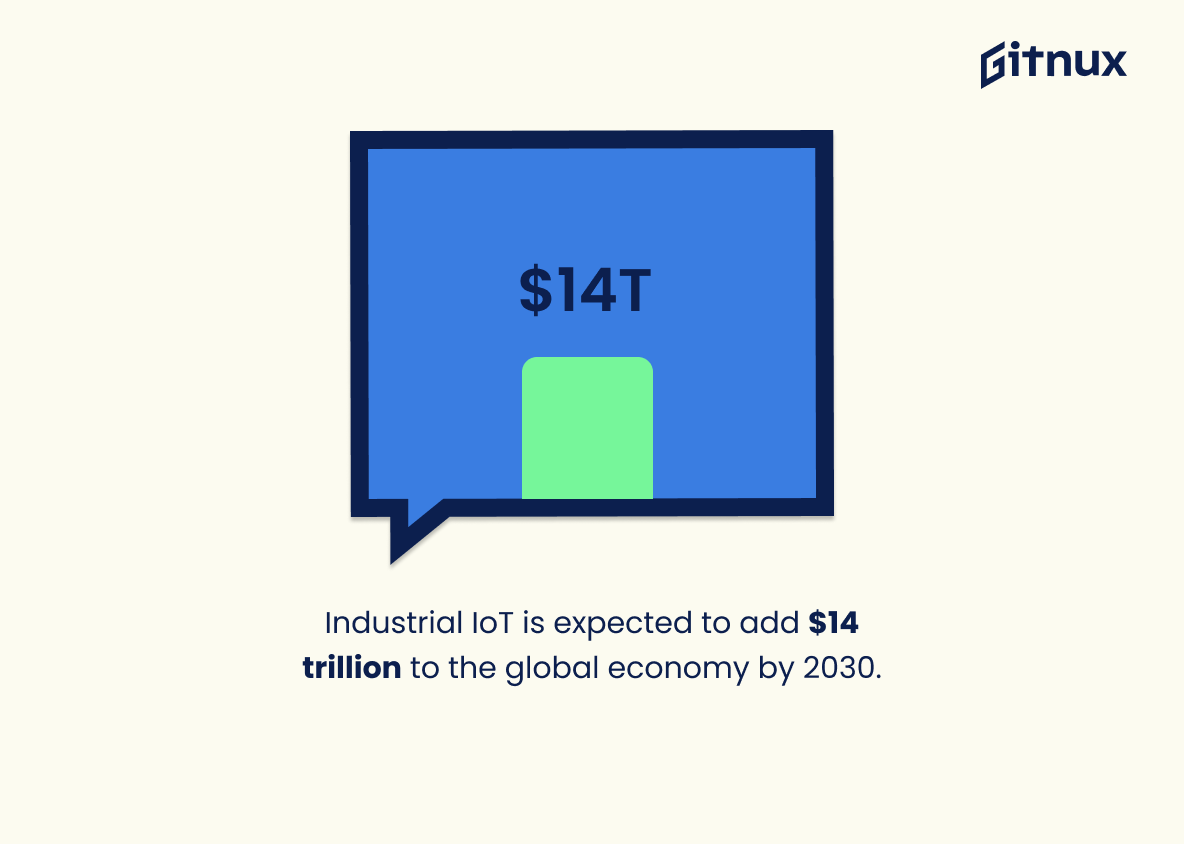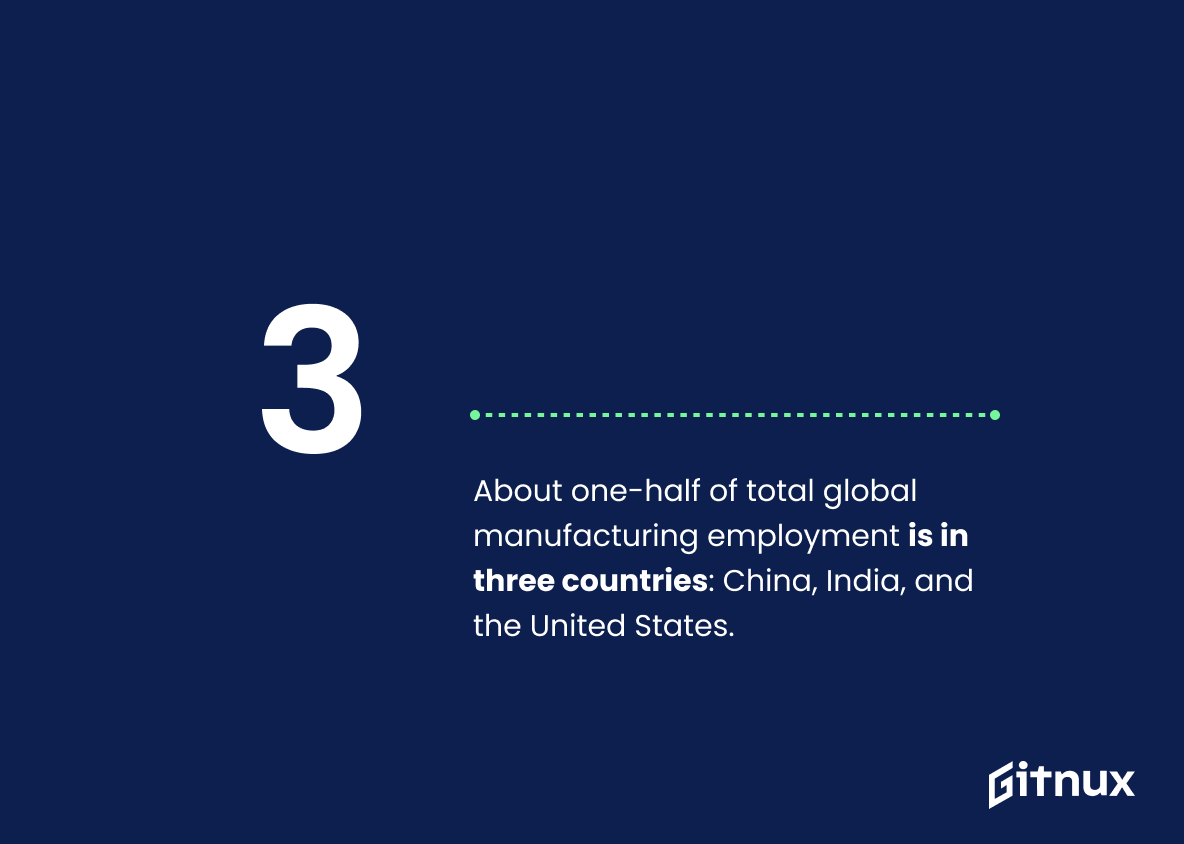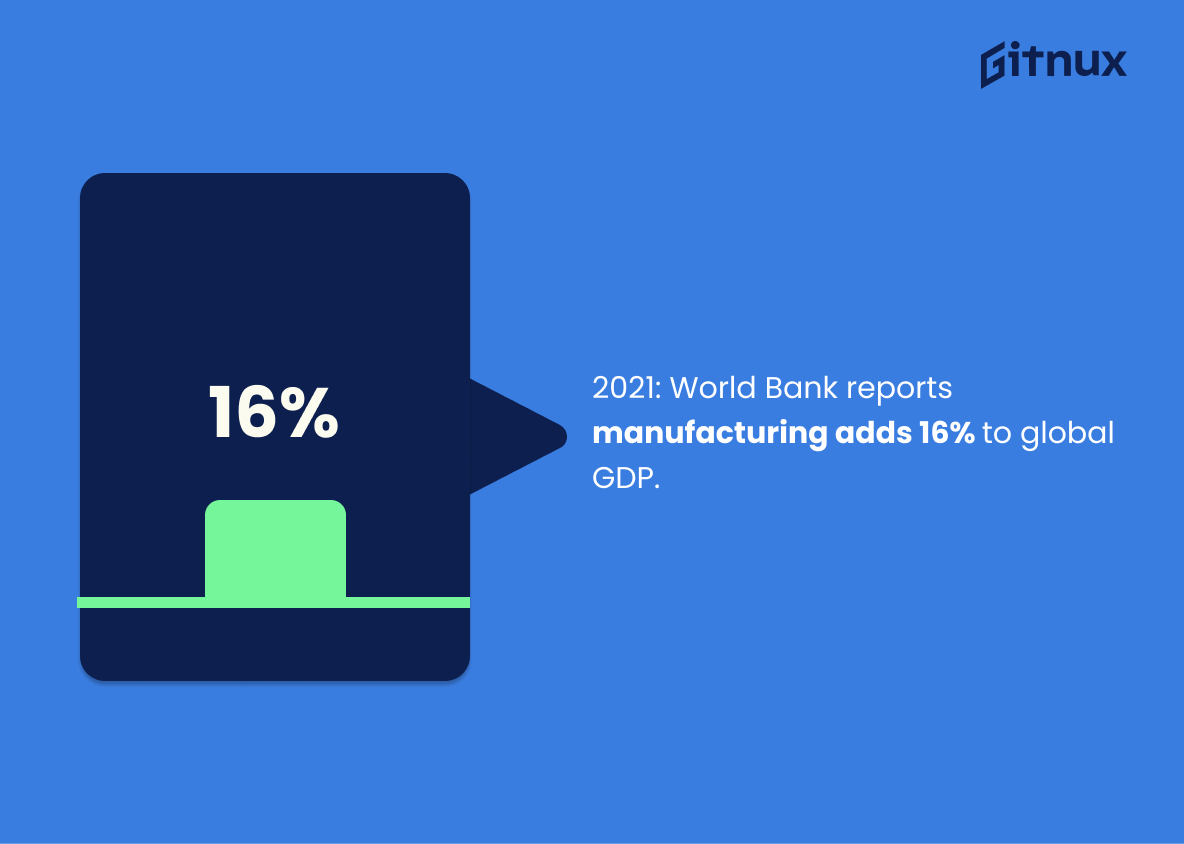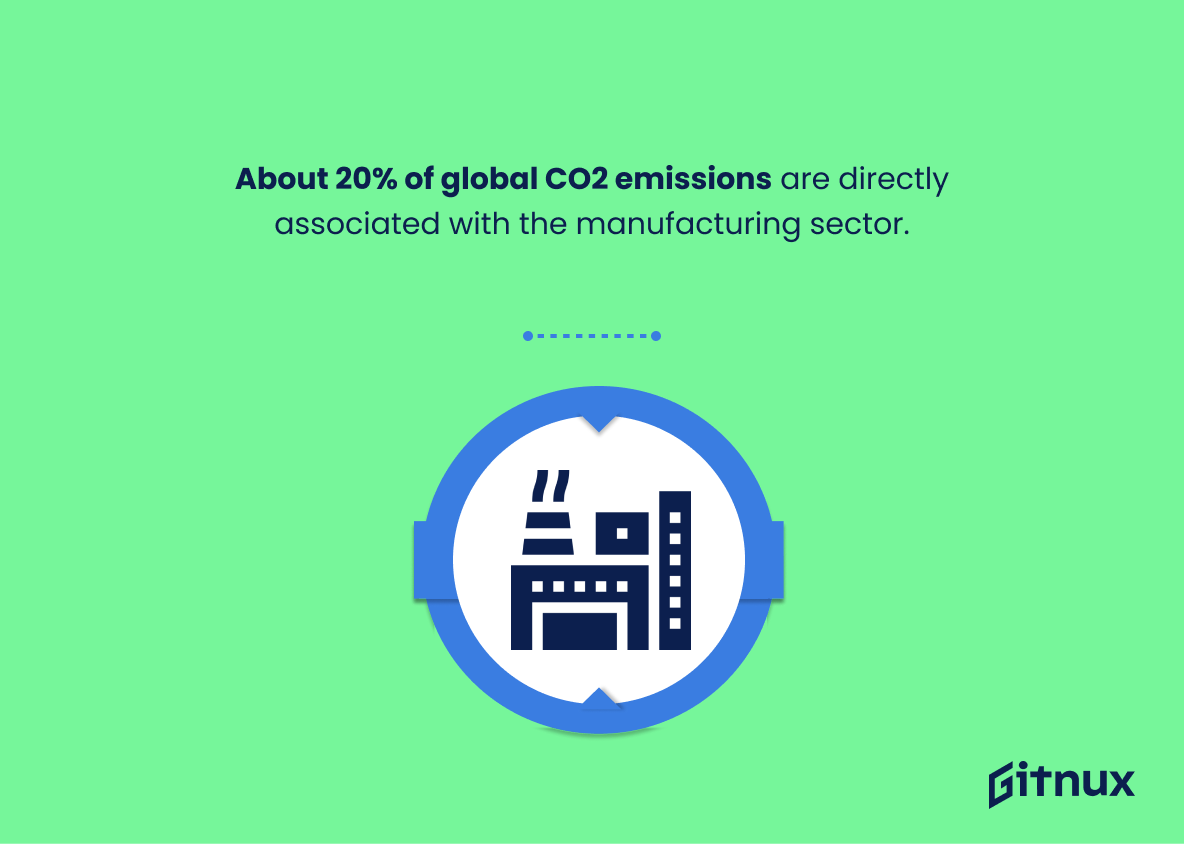Embarking on a journey through the wilderness of factors and figures, the blog post ahead offers a comprehensive exploration into the expansive world of the global manufacturing industry. Renowned for its sprawling influence and direct impact on economic landscapes, this sector remains a dynamic and ever-evolving domain. Within the upcoming content, we’ll dive into key insights and unravel the fascinating statistics that continue to shape this industry globally. Whether you are a business enthusiast, a statistician, an industry expert, or simply curious, this contemplative investigation of global manufacturing industry statistics promises to enlighten, inform, and provoke thought around the subject’s true scope and magnitude.
The Latest Global Manufacturing Industry Statistics Unveiled
The global manufacturing sector is estimated to reach a value of around $8.94 trillion by 2022.
By envisaging a value of around $8.94 trillion for the global manufacturing sector by 2022, we are in essence peeking into the extraordinary potential that lies within this industry. This figure serves as a testament to the escalating speed and scale of manufacturing worldwide, shedding light on how nations are investing resources and technology to compete in the global stage. It also paints a vivid picture of the economic might wielded by the manufacturing industry, making it a critical driving force behind the world’s economic wheel. Without a doubt, this monetary marker penned by statistical data will play a key role in predictions, future trends, and strategic planning for business leaders and policy-makers dealing with global manufacturing, effectively influencing their decisions.
According to the Global Manufacturing Outlook, 47% of the manufacturing leaders expect that global economic conditions will be less favorable in the next 12 months.
Perusing through this significant percentage marker, ingrained within the Global Manufacturing Outlook, lends itself as a compass to industry sentiments and investment risks. The anticipation of 47% of manufacturing leaders for less favourable economic conditions within the incoming 12 months creates an aura of caution and opportunity in the challenging seas of manufacturing industry. This potentially implies a cautious investment climate, decision-making, and strategic planning for the near future, all of which are vital aspects to be considered in the broader industry analysis. Moreover, with nearly half of the industry leaders preparing for a rougher economic road, the understanding and assessment of this statistic becomes a crucial factor in any credible discussion around Global Manufacturing Industry trends and patterns.
China is the largest manufacturing country in the world with manufacturing contributing to 28.4% of its GDP.
Painting the macroeconomic canvas of global manufacturing, China ascends as a titan, with manufacturing forming 28.4% of its GDP. This vibrant tapestry of numbers is compelling in the context of a global manufacturing industry exposition. Aligning China’s manufacturing prowess with nearly a third of its massive GDP punctuates the country’s global influence, serving as both an indicator and a potential predictor for international manufacturing trends. The formidable Chinese manufacturing domain shapes global supply chains, influencing patterns of trade, investment, and economic growth worldwide. When unpacking the sphere of global manufacturing, overlooking China’s preeminence would be tantamount to missing a pivotal piece of this intricate puzzle.
The global manufacturing industry lost almost $8 trillion in value in 2020 due to the COVID-19 pandemic.
In a vast ocean of figures and facts, one number stands as a lighthouse warning of a devastating storm; the global manufacturing industry suffered nearly $8 trillion in losses in 2020 as a result of the COVID-19 pandemic. This dramatic figure gears the attention towards the immense scale and magnitude of the disruption caused by the pandemic. It underscores the ripple effects felt across supply chains, production lines, workforces, and consumer demand. Essentially, it becomes the heartbeat in the dialogue around the state of the global manufacturing industry, guiding the narrative and wielding potential to stimulate strategies for recovery and future resilience.
McKinsey predicts that industrial robotics will become a $14 billion market by 2025 globally.
The captivating prediction by McKinsey should not be underestimated as it highlights a seismic shift toward industrial robotics in the global manufacturing industry. Riveting our focus towards a potential $14 billion market by 2025, it underscores the increasing appetite for automation, efficiency, and precision in manufacturing processes. In an era of fierce competition and innovation, this statistic ignites a sense of urgency for manufacturers to embrace robotics, underlining its potential to drive growth, profitability, and industry sustainability in the not-so-distant future. Suffice it to say, those turning a blind eye to these implications may find themselves losing terrain in the manufacturing arena.
41% of global manufacturing companies are using predictive analytics.
Peering into the looking glass of global manufacturing industry statistics, we unearth an intriguing revelation encased in digits and percentages – a significant 41% of worldwide manufacturing companies are harnessing the predictive power of analytics. This surging tide of data-driven foresight signifies an important industry-wide shift toward proactive problem-solving and strategy optimization methods.
The reliance on predictive analytics serves as a powerful testament to the evolving industrial landscape where data has taken the driver’s seat. It also underscores how companies are increasingly merging quantitative predictions with qualitative judgment to make informed decisions, identify new opportunities and minimize risk.
This considerable proportion also implies that the remaining 59%, not yet partaking in this strategic feast, may be missing out on vital competitive advantages in an already fierce marketplace. The numbers thus conjure a crucial narrative that urges manufacturing industries across the globe to delve into the world of predictive analytics or risk being left behind in the exhilarating race of innovation and foresight.
79% of the companies included in the Deloitte global manufacturing competitive index say advanced technologies — robotics, smart, connected products, etc. — are important today.
Peering into the heart of the global manufacturing landscape, the statistic that 79% of companies acknowledged the significance of advanced technologies, namely robotics and smart, connected products, turns a thrilling page in this narrative. Firmly highlighting the evolving dance between technology and manufacture, it underscores the transition from traditional, manual practices to embracing a more automated future. Pivoting to this tech-focused approach not only fuels efficiency and production improvements, but also increases competitiveness, pushing an overwhelming majority of industry players to seriously weigh the impact of technological advancement. To put it simply, this number is the pulse rate indicating how fully manufacturer’s veins are infused with technology. Showcasing this shift towards deeper digital integration in a blog post about global manufacturing industry statistics can illuminate the direction that the wind of innovation is blowing, and provide valuable insights for those eager to sail along.
By 2022, 75% of all manufacturers will be engaged in some form of cloud-based manufacturing execution system.
Highlighting the shift towards cloud-based manufacturing execution systems offers key insights into the changing landscape of the global manufacturing industry. The forecasted statistic that 75% of all manufacturers will have adopted this cloud-based approach by 2022 underscores several industry trends. Firstly, it underpins the industry’s growing dependence on technology, as manufacturers increasingly invest in digitization to streamline and optimize their operations. Secondly, it hints at the rising prevalence of remote work and distributed manufacturing processes – a trend that cloud-based systems notably facilitate. Finally, it underscores the considerable scale of the transformation; depicting not just a few early adopters, but a widespread industry shift towards cloud-based technologies. Thus, this statistic serves as a vital barometer for assessing the velocity and magnitude of technological evolution within the global manufacturing sector.
In 2018, the computer and peripheral equipment manufacturing industry had the largest number of foreign direct investment projects in the manufacturing sector worldwide, with roughly 375 projects.
Diving into the essence of this pivotal statistic surrounds us with an insightful understanding of the global manufacturing industry. A glimpse into 2018 reveals a remarkable dominance of the computer and peripheral equipment manufacturing industry as it led the parade with an impressive 375 foreign direct investment projects worldwide. This leadership position cements its significance and influence in the global manufacturing landscape. This information becomes indispensable when painting an authentic picture of the industry. Not only does it highlight the influence of technology in manufacturing, but it also reflects the strategic choices made by international investors, positioning this sector as a dynamic epicenter of global manufacturing transformation. This captivating statistic offers an engaging starting point to unravel the evolving trends and driving forces behind the fascinating dance of global manufacturing industries.
In 2021, the global manufacturing sector’s revenue fell by approximately 5.4% compared to the previous year.
Drawing attention to the ribbon of change in the context of the Global Manufacturing Industry Statistics, the 5.4% decline in revenue reveals a pressing inflection point for the sector in 2021. This dip in numbers functions like a mirror, reflecting the challenges that swept over the industry, possibly due to unforeseen events like the COVID-19 pandemic or economic fluctuations. This powerful percentage serves as an undeniable testament to the various external factors significantly influencing the making, selling and buying of goods, signalling a ripple effect that can reshape the future course of the manufacturing industry worldwide. It ignites discussions on the vulnerabilities of the sector and the need for effective resilience strategies.
By 2023, the global smart manufacturing market size is expected to reach $506.33 billion.
Painting an image of the future, the anticipated swell of the global smart manufacturing market to $506.33 billion by 2023 thrusts itself into significance. This projection soothes the canvas of the Global Manufacturing Industry with hues of futuristic growth and technological innovation. An author crafting a blog post on this subject cannot ignore such a euphony of data. It’s akin to a melody, whispering of industries metamorphosing, adapting to the symphony of the digital age. This figure underlines the narrative of progression, reinforcing the pivotal role of technology in manufacturing landscapes worldwide. It carries the promise of a transforming industry, spurred by the winds of smart manufacturing, and, at the same time, it serves as a catalyst beckoning entrepreneurs, innovators, and leaders to invest, participate and shape this unfolding reality.
Industrial IoT is expected to add $14 trillion to the global economy by 2030.
Setting the stage for a staggering economic transformation, it’s predicted that Industrial IoT will inject a staggering $14 trillion into the global economy by 2030. In the context of Global Manufacturing Industry Statistics, this projection doesn’t just represent an enormous figure. It’s a pulsating indicator of the forward momentum that advanced digital technologies will inject into the manufacturing industry and global economy.
As manufacturing firms around the globe harness the power of Industrial IoT, efficiencies will skyrocket. Picture improved operational efficiencies, enhanced product quality, expedited time-to-market, and increased worker safety on a world-wide scale. Those factors will help shape the manufacturing landscape and the implications are far-reaching, touching every corner of the global economy.
This means not only the growth for the manufacturers but a ripple effect across ancillary industries. As manufacturers procure more IoT devices, the technology industry soars. As production streamlines, logistics firms will scramble to keep pace. The reverberations will echo through every tier of economic exchange, culminating in a $14 trillion boost to our global economy by the completion of this exciting, transformative decade. Hence, in the grand tapestry of global manufacturing statistics, the anticipated impact of Industrial IoT is neither a mere detail nor an impressive testament to the digital age’s rapid advancements. It’s a resounding clarion call of economic growth, innovation, and unmatched potential.
About one-half of total global manufacturing employment is in three countries: China, India, and the United States.
Unboxing this insightful statistic provides a glimpse into the gravitational pull of three key players in the global manufacturing landscape – China, India, and the United States. This trio, holding the reins of nearly half of the world’s manufacturing employment, paints a vivid portrait of worldwide manufacturing activity concentration within their borders.
As the vertices of this manufacturing trifecta, these countries bridge the east-west divide, underpinning the interplay between labor-intensive manufacturing and high-end production. For an aspiring manufacturer or potential investor perusing this blog, these facts might unravel valuable focal points for decision-making processes—ranging from identifying market opportunities to understanding geopolitical influences on supply chains. Furthermore, it spotlights the socio-economic dimensions of the world’s manufacturing machine, demystifying the multi-layered narrative of industrial evolution, labor market dynamics, and economic growth in its raw essence.
As of 2021, the World Bank reported that the manufacturing sector’s value added to the global gross domestic product was approximately 16%.
Highlighting that the manufacturing sector contributed roughly 16% to the global GDP as documented by the World Bank in 2021 is pivotal to our understanding of worldwide manufacturing industry movements. It aids in discerning the sheer economic weight of this sector. Moreover, it enables readers to wrap their heads around the manufacturing industry’s crucial role in pumping life into the global economy. Such contribution implies that not only millions of jobs are secured but it also symbolizes the industry’s capacity to innovate and spearhead technological advancements. Therefore, knowing these percentages is like viewing the lifeblood of the global economy under a magnifying glass, affirming the sector’s critical relevance and power.
About 20% of global CO2 emissions are directly associated with the manufacturing sector.
Painting a vivid picture of the global manufacturing industry wouldn’t be complete without addressing its environmental footprint. The statistic outlines a stark reality; one fifth of the world’s CO2 emissions stem directly from manufacturing activities. This concrete figure underscores the scale of the sector’s environmental impact, plainly illustrating the role it plays in a growing global issue. With global warming and climate change being front and center of global discourse, this number frames a pivotal responsibility of the manufacturing sector – to innovate and transform towards sustainability. It’s a call to action, of sorts, emphasizing the need for green manufacturing practices, development of energy-efficient products, and investment in a sustainable future.
According to a report, women make up approximately 29% of the manufacturing workforce.
Unfolding the gender narrative in traditionally male-dominated sectors like manufacturing, the statistic depicting that nearly three in every ten manufacturing workers are women, provides a compelling frame of reference. It embodies the stride of female workforce in breaking the barriers and penetrating the steel ceiling of the manufacturing world. Moreover, in the arena of global manufacturing statistics, this number offers a pivotal measure of diversity and inclusivity within this sector. Finally, understanding these percentage points aids in encouraging further dialogue and policies directed towards gender equality, hence nudging a balanced workforce that could potentially serve as a catalyst for innovation, productivity, and economic growth on a global scale.
The global industrial automation market in the manufacturing sector is anticipated to increase by over $44 billion during 2020-2024, progressing at a CAGR of about 5% during the forecast period.
A healthy pulse of the global manufacturing industry reveals itself through the predicted surge in the industrial automation market. As per the quoted figures, the anticipation of a $44 billion increment from 2020 to 2024 indicates a significant trend. What drives the intrigue here is a compounded annual growth rate (CAGR) of near 5%.
An undercurrent of this information lies in its connection to a strong swing towards advanced automation among manufacturers worldwide. This trend is transformative, impacting industry patterns and practices, creating new job roles, and redefining old ones. Hence, the significance of this statistic goes beyond numbers and presents a compelling narrative about the evolving manufacturing sector in the global economy, a central theme for any blog focusing on Global Manufacturing Industry Statistics.
The global manufacturing sector experienced productivity growth of 2.8% in 2018.
Illuminating the hard facts and drawing out the contours of an increasingly sophisticated economic landscape, the 2.8% productivity growth in the global manufacturing sector in 2018 offers an optimistic bookmark in the narrative of global manufacturing industry statistics. This promising uptick deftly alludes to the industry’s relentless pursuit of efficiency, introducing advancements in manufacturing technologies and methodologies that could fuel sustainable productivity in the future. Furthermore, it provides a testament to the industry’s adaptability and resilience amidst fluctuating market conditions and emerging challenges, reminding stakeholders of their integral role in the wider global economy.
The manufacturing sector shares in world trade. The largest economies, such as China (18%), the US (9%), and Germany (8%), dominate world manufacturing trade.
Highlighted by this captivating statistic, a sense of international economic power play becomes visible. Capturing an ample 18% representation in this global arena, China clearly leads the pack in the manufacturing sector of world trade. Not too far behind, the US and Germany trail with significant contributions of 9% and 8% respectively.
The potency of this data is illuminated when appreciating its role in shaping the narrative of the Global Manufacturing Industry statistics, especially in a blog post context. As layers of the global manufacturing kaleidoscope, these strong candidates (China, the US, Germany) signify the vanguard of world trade, their contributions providing the backbone to global production endeavours.
The nuances of this statistic reverberate throughout the manufacturing industry, influencing decisions of multinational corporations, policy makers, and economists. Each percentage point hints at the complex interplay of numerous factors – labor costs, technology level, government policies, infrastructure, to name just a few. A thorough understanding of this statistic may indeed shed light on the competitive edge that the leading economies possess, as well as the potential opportunities for other economies to elevate their standings in this global race.
Ultimately, tracing these patterns, both apparent and subliminal, is crucial in shaping perspectives, informing strategies, and stimulating thought-provoking discourses on the global manufacturing industry landscape.
Conclusion
In conclusion, the Global Manufacturing Industry is undeniably a titan of economic stability, growth and employment opportunities. The facts and figures that we’ve highlighted just scratch the surface of this dynamic and rapidly evolving industry. Despite recent challenges, the strong surge in innovative manufacturing techniques, sustainability measures, and technological advancements demonstrate the resilience and diversity of the global manufacturing sector. The statistics underline the fact that manufacturing continues to play a pivotal role in strengthening the global economy. Therefore, understanding these trends and statistics is imperative for strategic planning and forecasting future growth in the global market scenario.
References
0. – https://www.www.ilo.org
1. – https://www.www.brookings.edu
2. – https://www.www.mckinsey.com
3. – https://www.www.cisco.com
4. – https://www.www.businesswire.com
5. – https://www.www.forbes.com
6. – https://www.home.kpmg
7. – https://www.www.statista.com
8. – https://www.www.alliedmarketresearch.com
9. – https://www.databank.worldbank.org
10. – https://www.cthrma.shrm.org
11. – https://www.www2.deloitte.com
12. – https://www.www.reuters.com
13. – https://www.www.fortunebusinessinsights.com
14. – https://www.www.ipcc.ch
15. – https://www.www.wto.org
16. – https://www.www.deloitte.com

